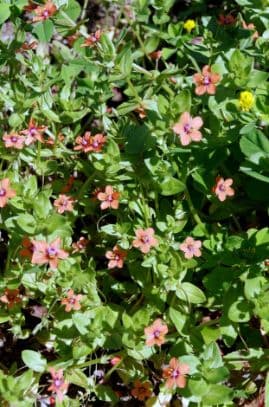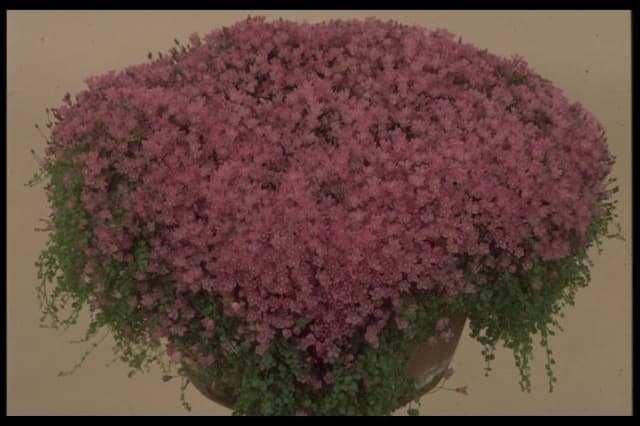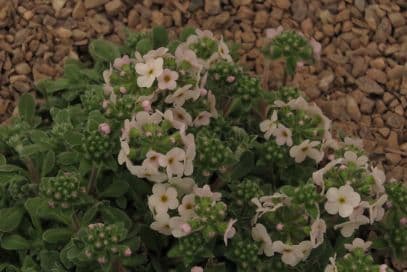Primrose Primula 'Tregor Truffle' (Pr/prim/d)

ABOUT
Primula 'Tregor Truffle' is a charming and colorful plant commonly known as a type of primrose. Its appearance is marked by a lush rosette of green leaves that form a lovely backdrop for the vibrant flowers. The leaves are typically broad and may have a slightly wrinkled texture which adds an interesting visual depth to the foliage. The true allure of the Primula 'Tregor Truffle' comes from its exquisite flowers. These blooms are known for their striking colors, which can vary from soft pastels to more vivid hues depending on the particular plant. The flowers are usually composed of five rounded petals that form a circular shape, often with a contrasting yellow or white center that gives them a dainty, eye-catching quality. Additionally, the edges of the petals may be delicately fringed or scalloped, creating a soft, ruffled effect that enhances the overall beauty of the flower. These blossoms are typically arranged in clusters that sit atop slender stems, gracefully rising above the foliage and creating a delightful display of color that can be especially appealing in garden settings or as part of a floral array. Overall, Primula 'Tregor Truffle' is a lovely and ornamental plant that is sure to capture the eye with its lush leaves and enchanting, richly colored flowers. Its ability to bring a splash of color to gardens and floral arrangements alike makes it a cherished choice for plant enthusiasts and gardeners.
About this plant
 Names
NamesFamily
Primulaceae.
Synonyms
No common names available.
Common names
Primula 'Tregor Truffle'
 Toxicity
ToxicityTo humans
Despite being a member of the Primula genus, the common primrose, including the Primula 'Tregor Truffle', is generally not considered highly toxic to humans. However, some individuals may be sensitive to primroses and can experience mild symptoms if ingested or if they come into contact with the skin. These symptoms might include mild nausea, vomiting, or diarrhea if eaten and dermatitis in sensitive individuals upon skin contact.
To pets
Primroses, including the Primula 'Tregor Truffle', are not known to be highly toxic to pets. However, ingestion of the plant can cause mild gastrointestinal upset in some animals, particularly if consumed in large quantities. Symptoms of poisoning may include vomiting, diarrhea, and drooling. If a pet exhibits signs of distress after consuming any part of the plant, it is advisable to consult with a veterinarian.
 Characteristics
CharacteristicsLife cycle
Perennials
Foliage type
Evergreen
Color of leaves
Green
Flower color
Varies
Height
6 inches (15 cm)
Spread
8 inches (20 cm)
Plant type
Herb
Hardiness zones
5
Native area
Europe
Benefits
 General Benefits
General Benefits- Attractive Flowers: Primula 'Tregor Truffle' is known for its beautiful blooms which can add aesthetic appeal to any garden space.
- Long Blooming Season: This variety typically has a longer blooming period, providing color and vibrance to your garden for an extended time.
- Compact Size: Being a smaller plant, it is ideal for use in rock gardens, containers, or small garden beds where space is limited.
- Easy to Grow: Primula 'Tregor Truffle' is known for being a hardy plant that is relatively easy to care for, making it suitable for novice gardeners.
- Attracts Pollinators: The flowers of the plant can attract bees, butterflies, and other pollinators, which is beneficial for the health of your garden.
- Versatility in Placement: It can thrive in various lighting conditions from full sun to partial shade, giving flexibility in garden design.
 Medical Properties
Medical PropertiesThis plant is not used for medical purposes.
 Air-purifying Qualities
Air-purifying QualitiesThis plant is not specifically known for air purifying qualities.
 Other Uses
Other Uses- Photography Prop: Primula 'Tregor Truffle' can be used by photographers seeking a unique and vibrant plant to include in spring-themed photo shoots.
- Cake Decoration: The edible flowers of the Primula can be crystallized or used fresh to adorn cakes and pastries, giving them an elegant and natural look.
- Fabric Dye: The pigments in Primula flowers have been historically used to dye fabrics, offering a range of soft colors.
- Art Supplies: Primula petals can be pressed and included in paper-making or used in creating botanical prints and natural collages by artists.
- Indicator Plant: Primulas can indicate soil health in gardens as they prefer rich, moist soil, offering gardeners a natural way to monitor their soil's condition.
- Edible Garnish: The flowers of Primula can be used to garnish salads and desserts, adding a splash of color and a mild, sweet flavor.
- Herbal Teas: While not a medical use, the flowers can be used to infuse herbal teas with a delicate flavor and aesthetic appeal.
- Children’s Educational Tool: Primulas can be used in educational settings to teach children about plant life cycles and seasonal changes in a hands-on manner.
- Sensory Gardens: As part of a sensory garden, different varieties of Primulas, including the 'Tregor Truffle', can provide visual stimulation and a light, pleasant fragrance.
- Ice Cubes: Freezing Primula flowers in ice cubes can create visually striking additions to cold beverages for special occasions.
Interesting Facts
 Feng Shui
Feng ShuiThe Primrose is not used in Feng Shui practice.
 Zodiac Sign Compitability
Zodiac Sign CompitabilityThe Primrose is not used in astrology practice.
 Plant Symbolism
Plant Symbolism- Youthfulness: As a variety of primrose, the Primula 'Tregor Truffle' often symbolizes youth and the freshness of spring, reminiscent of the early emergence of primroses during the year.
- Hope: Primroses are often associated with hope, as they are one of the first flowers to bloom in spring, signaling the end of winter and the start of new growth.
- New beginnings: Echoing the theme of early spring, primroses like the Primula 'Tregor Truffle' represent new beginnings and the start of new ventures.
- Love: In the language of flowers, primroses can symbolize young love or love in its early stages, denoting affection and adoration.
- Eternal existence: The perennial nature of the plant reflects the idea of continuity and the cycle of life, suggesting an underlying eternal existence.
 Water
WaterEnglish Primrose requires consistent moisture, so water it thoroughly whenever the top inch of soil feels dry to the touch. Generally, this may be about once a week, but it can vary based on the climate and indoor conditions. Provide about one inch of water each time, which could translate to roughly half a gallon for a standard-sized pot. During the active growth period in spring and summer, the watering frequency may increase. However, be careful to avoid waterlogging the soil, as this can lead to root rot and other issues.
 Light
LightEnglish Primrose thrives in bright, indirect light and should be placed in a location where it can receive this type of light for most of the day. It can tolerate some morning sunlight, but too much direct sun can scorch the leaves. A spot near an east-facing window would be ideal, offering the plant a gentle blend of light without the harsh midday sun.
 Temperature
TemperatureEnglish Primrose prefers cool to moderate temperatures between 50 to 70 degrees Fahrenheit. It can handle brief dips to just above freezing, but temperatures below 30 degrees Fahrenheit can be damaging to the plant. The ideal temperature range would be between 60 and 65 degrees Fahrenheit, as too much heat can cause the plant to become leggy and may affect flowering.
 Pruning
PruningEnglish Primrose should be pruned to remove dead or faded flowers, which encourages new blooms and helps maintain the plant's appearance. This task is typically done after the main blooming period, though spent flowers can be removed as needed throughout the blooming season. Pruning should be done carefully with clean, sharp scissors or pruners to prevent damage to the plant.
 Cleaning
CleaningAs needed
 Soil
SoilPrimula 'Tregor Truffle', commonly known as English Primrose, thrives in well-draining, humus-rich soil with a slight acidity to neutral pH, around pH 6.0 to 7.0. A soil mix with one-part garden soil, one-part compost or well-rotted manure, and one-part perlite or coarse sand is ideal for ensuring good drainage and fertility.
 Repotting
RepottingEnglish Primrose, or Primula 'Tregor Truffle', should be repotted every 1 to 2 years. Choose a slightly larger pot to give the roots room to grow and refresh the soil to provide new nutrients.
 Humidity & Misting
Humidity & MistingEnglish Primrose (Primula 'Tregor Truffle') prefers high humidity levels, around 50-60%. To maintain optimal humidity, consider grouping plants together or using a humidity tray.
 Suitable locations
Suitable locationsIndoor
Place in bright, indirect light and keep soil moist.
Outdoor
Plant in part shade, shelter from harsh sun.
Hardiness zone
5-9 USDA
 Life cycle
Life cycleThe life cycle of Primula 'Tregor Truffle', commonly known as Tregor Truffle Primrose, begins with seed germination, which typically occurs in moist soil conditions with good indirect light. The seeds develop into small seedlings with a few leaves, entering the vegetative growth phase, during which leaf development and root system expansion are prioritized. Following the vegetative stage, the plant enters the flowering phase, usually in early spring, when it produces ornate, usually double-flowered blossoms that can vary in color. After pollination, the flowers produce seeds, completing the reproductive cycle. Once the flowering has finished, the plant may enter a period of dormancy, especially if grown in regions with colder climates, conserving energy for the next growing season. With the return of favorable growing conditions, the plant resumes growth from its rootstock, repeating its vegetative and reproductive cycle annually.
 Propogation
PropogationPropogation time
Spring to Summer
The most popular method of propagation for Primula 'Tregor Truffle', commonly known as a type of Primrose, is by division. This typically should be done in the late winter or early spring just before new growth begins. The process involves gently taking the plant out of the ground or its container and carefully separating the clump into smaller sections, each with several leaves and a healthy set of roots. These divisions are then replanted at the same soil depth they were originally growing at, and watered thoroughly to help establish their roots in a new location. Ideally, the divisions should be spaced about 6 to 12 inches (15 to 30 centimeters) apart to allow for adequate growth. After planting, the divisions should be kept moist and be given time to establish, which may take a few weeks, before the plant resumes its normal growth and flowering.









